| Calculation of Return on Adjusted | | | | | | | |
Invested Capital
(Excluding Acquisition
Intangible Amortization)12 | | 2023 | | 2022 | | 2021 | |
| ANOPAT | | $ | 599.7 | | | $ | 548.2 | | | $ | 454.3 | | |
| Invested capital (two-point average) | | | 4,332.0 | | | | 3,785.0 | | | | 3,527.5 | | |
| Return on invested capital | | | 13.8 | % | | | 14.5 | % | | | 12.9 | % | |
| Reconciliation of Free Cash Flow13 | | 2023 | | 2022 | |
| Net cash provided by operating activities | | $ | 545.2 | | | $ | 463.8 | | |
| Capital expenditure | | | (187.8 | ) | | | (178.4 | ) | |
| Free cash flow | | $ | 357.4 | | | $ | 285.4 | | |
| Reconciliation of Net Debt14 | | 2023 | |
| Short-term debt | | $ | 605.6 | | |
| Long-term debt | | | 1,790.3 | | |
| Total debt | | $ | 2,395.9 | | |
| Less: Cash and cash equivalents | | | 418.9 | | |
| Net debt | | $ | 1,977.0 | | |
| Ratio of net debt to adjusted EBITDA | | | 2.1 | | |
| | | | | | | | | | | | |
| | | | | | | |
| Reconciliation of Adjusted Invested Capital | | 2021 | | 2020 | | 2019 | | 2018 | | 2017 | | |
| | | | | | |
Total debt | | $1,464.9 | | $1,564.6 | | $1,730.1 | | $1,681.6 | | $962.3 | | |
| | | | | | |
Total equity | | $2,377.7 | | $2,225.2 | | $1,954.8 | | $1,642.7 | | $1,474.9 | | |
| | | | | | | |
Invested capital (Total debt + Total equity) | | $3,842.6 | | $3,789.8 | | $3,684.9 | | $3,324.3 | | $2,437.2 | | |
| | | | | | |
Invested capital (two-point average) | | $3,816.2 | | $3,737.4 | | $3,504.6 | | $2,880.8 | | | | |
| | | | | | |
| | | | | | | | | | | | | |
| Calculation of Return on Adjusted Invested Capital7 | | 2021 | | 2020 | | 2019 | | 2018 | | | | |
| | | | | | |
ANOPAT | | $418.8 | | $368.7 | | $416.3 | | $367.9 | | | | |
| | | | | | |
Invested capital (two-point average) | | $3,816.2 | | $3,737.4 | | $3,504.6 | | $2,880.8 | | | | |
| | | | | | |
Return on invested capital | | 11.0% | | 9.9% | | 11.9% | | 12.8% | | | | |
| | | | | | |
| | | | | | | | | | | | |
| | | | | | | |
| Reconciliation of Free Cash Flow8 | | 2021 | | 2020 | | | | | | | | |
| | | | | | |
Net cash provided from operating activities | | $387.3 | | $577.6 | | | | | | | | |
| | | | | | |
Less: capital expenditures | | $148.3 | | $121.6 | | | | | | | | |
| | | | | | |
Free cash flow | | $239.0 | | $456.0 | | | | | | | | |
| | | | | | |
| | | | | | | | | | | | | |
| | | | | | |
| Reconciliation of Net Debt9 | | 2021 | | 2020 | | | | | | | | |
| | | | | | |
Short-term debt | | $53.8 | | $130.7 | | | | | | | | |
| | | | | | |
Long-term debt | | $1,411.1 | | $1,433.9 | | | | | | | | |
| | | | | | |
Total debt | | $1,464.9 | | $1,564.6 | | | | | | | | |
| | | | | | |
Less: cash and cash equivalents | | $257.1 | | $320.3 | | | | | | | | |
| | | | | | |
Net debt | | $1,207.8 | | $1,244.3 | | | | | | | | |
A-2
| Reconciliation of Net Income to Adjusted | | | | | | | | | | | | |
| Net Income (Including Acquisition Intangible Amortization)1 | | 2023 | | 2022 | | 2021 | | 2020 | | 2019 | | 2018 |
| Net Sales | | $ | 4,769.0 | | | $ | 4,496.7 | | | $ | 4,132.9 | | | $ | 3,513.2 | | | $ | 3,789.9 | | | $ | 3,580.8 | |
| Net Income Attributable to | | | | | | | | | | | | | | | | | | | | | | | | |
| The Timken Company | | | 394.1 | | | | 407.4 | | | | 369.1 | | | | 284.5 | | | | 362.1 | | | | 302.8 | |
| Net Income Attributable to The Timken | | | | | | | | | | | | | | | | | | | | | | | | |
| Company as a Percentage of Sales | | | 8.3 | % | | | 9.1 | % | | | 8.9 | % | | | 8.1 | % | | | 9.6 | % | | | 8.5 | % |
| Adjustments: | | | | | | | | | | | | | | | | | | | | | | | | |
Impairment, restructuring and
Reorganization charges2 | | | 51.6 | | | | 39.5 | | | | 15.1 | | | | 29.0 | | | | 9.8 | | | | 7.1 | |
| Corporate pension and other postretirement benefit related expense (income)3 | | | 20.6 | | | | 2.9 | | | | 0.3 | | | | 18.5 | | | | (4.1 | ) | | | 12.8 | |
| Acquisition-related charges4 | | | 31.8 | | | | 14.8 | | | | 3.2 | | | | 3.7 | | | | 15.5 | | | | 20.6 | |
| Acquisition-related gain5 | | | — | | | | — | | | | (0.9 | ) | | | (11.1 | ) | | | — | | | | — | |
| Russia-related charges6 | | | 8.5 | | | | 15.6 | | | | — | | | | — | | | | — | | | | — | |
| Gain (loss) on divestitures and sales of certain assets7 | | | (5.2 | ) | | | (2.9 | ) | | | — | | | | (0.4 | ) | | | (4.5 | ) | | | 0.8 | |
| Property losses (recoveries) and related expenses8 | | | — | | | | — | | | | — | | | | (5.5 | ) | | | 7.6 | | | | — | |
| Brazil legal matter | | | — | | | | — | | | | — | | | | — | | | | 1.8 | | | | — | |
| Tax indemnification and related matters | | | — | | | | 0.3 | | | | 0.2 | | | | 0.5 | | | | 0.7 | | | | 1.5 | |
| Non-controlling interest of above adjustments | | | (2.1 | ) | | | (5.3 | ) | | | — | | | | (0.1 | ) | | | (0.5 | ) | | | (1.3 | ) |
| Provision for income taxes9 | | | (40.1 | ) | | | (24.5 | ) | | | (23.6 | ) | | | (6.0 | ) | | | (34.6 | ) | | | (16.8 | ) |
| Adjusted Net Income | | $ | 459.2 | | | $ | 447.8 | | | $ | 363.4 | | | $ | 313.1 | | | $ | 353.8 | | | $ | 327.5 | |
| Reconciliation of Diluted EPS to Adjusted EPS | | | | | | | | | | | | |
(Including Acquisition
Intangible Amortization)1 | | 2023 | | 2022 | | 2021 | | 2020 | | 2019 | | 2018 |
| Diluted Earnings Per Share (EPS) | | $ | 5.47 | | | $ | 5.48 | | | $ | 4.79 | | | $ | 3.72 | | | $ | 4.71 | | | $ | 3.86 | |
| Adjusted EPS | | $ | 6.37 | | | $ | 6.02 | | | $ | 4.72 | | | $ | 4.10 | | | $ | 4.60 | | | $ | 4.18 | |
| Diluted Shares | | | 72,081,884 | | | | 74,323,839 | | | | 77,006,589 | | | | 76,401,366 | | | | 76,896,565 | | | | 78,337,481 | |
| Reconciliation of Adjusted Net Operating | | | | | | | | | | | | |
| Profit After Taxes (ANOPAT) (Including Acquisition Intangible Amortization) | | 2023 | | 2022 | | 2021 | | 2020 | | 2019 | | 2018 |
| Adjusted EBITDA1. 11 | | $ | 939.7 | | | $ | 855.9 | | | $ | 718.0 | | | $ | 658.9 | | | $ | 726.3 | | | $ | 646.5 | |
| Less: Depreciation and amortization10 | | | 200.5 | | | | 164.0 | | | | 167.0 | | | | 164.0 | | | | 159.9 | | | | 146.0 | |
| Adjusted EBIT | | | 739.2 | | | | 691.9 | | | | 551.0 | | | | 494.9 | | | | 566.4 | | | | 500.5 | |
| Adjusted tax rate | | | 25.5 | % | | | 25.5 | % | | | 24.0 | % | | | 25.5 | % | | | 26.5 | % | | | 26.5 | % |
| Calculated income taxes | | | 188.5 | | | | 176.4 | | | | 132.2 | | | | 126.2 | | | | 150.1 | | | | 132.6 | |
| ANOPAT | | $ | 550.7 | | | $ | 515.5 | | | $ | 418.8 | | | $ | 368.7 | | | $ | 416.3 | | | $ | 367.9 | |
| Reconciliation of Adjusted | | | | | | | | | | | | | | |
Invested Capital
(Including Acquisition
Intangible Amortization) | | 2023 | | 2022 | | 2021 | | 2020 | | 2019 | | 2018 | | 2017 |
| Total debt | | $ | 2,395.9 | | | $ | 1,963.2 | | | $ | 1,464.9 | | | $ | 1,564.6 | | | $ | 1,730.1 | | | $ | 1,681.6 | | | $ | 962.3 | |
| Total equity | | | 2,702.4 | | | | 2,352.9 | | | | 2,377.7 | | | | 2,225.2 | | | | 1,954.8 | | | | 1,642.7 | | | | 1,474.9 | |
Invested capital (total debt
plus total equity) | | | 5,098.3 | | | | 4,316.1 | | | | 3,842.6 | | | | 3,789.8 | | | | 3,684.9 | | | | 3,324.3 | | | | 2,437.2 | |
Invested capital (two-point
average) | | $ | 4,707.2 | | | $ | 4,079.4 | | | $ | 3,816.2 | | | $ | 3,737.4 | | | $ | 3,504.6 | | | $ | 2,880.8 | | | | | |
| Calculation of Return on Adjusted | | | | | | | | | | | | |
Invested Capital
(Including Acquisition
Intangible Amortization)12 | | 2023 | | 2022 | | 2021 | | 2020 | | 2019 | | 2018 |
| ANOPAT | | $ | 550.7 | | | $ | 515.5 | | | $ | 418.8 | | | $ | 368.7 | | | $ | 416.3 | | | $ | 367.9 | |
| Invested capital (two-point average) | | | 4,707.2 | | | | 4,079.4 | | | | 3,816.2 | | | | 3,737.4 | | | | 3,504.6 | | | | 2,880.8 | |
| Return on invested capital | | | 11.7 | % | | | 12.6 | % | | | 11.0 | % | | | 9.9 | % | | | 11.9 | % | | | 12.8 | % |
1Management believes consolidated earnings before interest, taxes, depreciation and amortization (EBITDA) is a non-GAAP measure that is useful to investors as it is representative of the Company’sCompany's performance and that it is appropriate to compare GAAP net income to consolidated EBITDA. Management also believes that non-GAAP measures of adjusted EBITDA, adjusted net income and adjusted diluted earnings per share are useful to investors as they are representative of the Company’sCompany's core operations and are used in the management of the business, including decisions concerning the allocation of resources and assessment of performance.
2 Impairment, restructuring and reorganization charges (including items recorded in cost of products sold) are relatedrelate to: (i) plant closures; (ii) the rationalization of certain plants; (iii) severance related to cost reduction initiatives; (iv) impairment of assets; and (iv)(v) related depreciation and amortization. Impairment, restructuring and reorganization charges for 2023 included $28.3 million related to the impairment of goodwill. Impairment, restructuring and reorganization charges for 2022 included $29.3 million related to the sale of Timken Aerospace Drives Systems, LLC. The Company reassessesre-assesses its operating footprint and cost structure periodically and makes adjustments as needed that result in restructuring charges. However, management believes these actions are not representative of the Company’s core operations.
3 Corporate pension and other postretirement benefit related expense (income) primarily represents actuarial losses and (gains) that resulted from the remeasurement of plan assets and obligations as a result of changes in assumptions. The Company recognizes actuarial losses and (gains) through earnings in connection with the annual remeasurement in the fourth quarter, or on an interim basis if specific events trigger a remeasurement.
Corporate pension and other postretirement benefit related expense (income) also includes curtailments.
4 Acquisition-related charges represent deal-related expenses associated with completed transactions and certain unsuccessful transactions, as well as any resulting inventory step-up impact.
5 The acquisition-related gain represents a bargain purchase price gain on the acquisition of the assets of Aurora Bearing Company that closed on November 30, 2020.
56 Russia-related charges include impairments or allowances recorded against certain property, plant and equipment, inventory and trade receivables to reflect the current impact of Russia's invasion of Ukraine (and associated sanctions) on the Company's operations. In addition to impairments and allowances recorded, the Company recorded a loss on the divestiture of its TimkenRus Service Company ooo business during the third quarter of 2022.
7 Represents the net gain (loss) resulting from divestitures and the sale of certain assets.
8 Property (recoveries) losses and related expenses represent property loss and related expenses during the periods presented (net of insurance recoveries received) that occurred during the first quarter of 2019 at one of the Company’sCompany's warehouses in Knoxville, Tennessee and during the third quarter of 2019 at one of the Company’sCompany's warehouses in Yantai, China.
69 Provision for income taxes includes the net tax impact on pre-tax adjustments (listed above), the impact of discrete tax items recorded during the respective periods as well as other adjustments to reflect the use of one overall effective tax rate on adjusted pre-tax income.
10 Depreciation and amortization shown excludes depreciation recognized in reorganization charges, if any.
711 See page A-1 for a reconciliation of Adjusted EBITDA to its most directly comparable GAAP financial measure.
12 The Company uses ANOPAT/Average Invested Capital as a non-GAAP ratio that indicates return on invested capital (ROIC), which is useful to investors as a measure of return on their investment.
813 Management believes that free cash flow is a non-GAAP measure that is useful to investors because it is a meaningful indicator of cash generated from operating activities available for the execution of its business strategy.
914 Management believes Net Debt is anand the Ratio of Net Debt to Adjusted EBITDA are important measuremeasures of the Company’sCompany's financial position, due to the amount of cash and cash equivalents on hand.
APPENDIX B
THE TIMKEN COMPANY
2019 EQUITY AND INCENTIVE COMPENSATION PLAN
(AMENDED AND RESTATED AS OF MAY 3, 2024)
1. Purpose. The purpose of this Plan is to permit award grants to Participants as incentives and rewards for service and/or performance.
2. Definitions. As used in this Plan:
(a) “Appreciation Right” means a right granted pursuant to Section 5 of this Plan.
(b) “Base Price” means the price to be used as the basis for determining the Spread upon the exercise of an Appreciation Right.
(c) “Board” means the Board of Directors of the Company.
(d) “Cash Incentive Award” means a cash award granted pursuant to Section 9 of this Plan.
(e) “Change in Control” has the meaning set forth in Section 13 of this Plan.
(f) “Code” means the Internal Revenue Code of 1986, as amended from time to time, and the regulations thereunder, as such law and regulations may be amended from time to time.
(g) “Committee” means the Compensation Committee of the Board (or its successor(s)), or any other committee of the Board designated by the Board to administer this Plan pursuant to Section 11 of this Plan. In addition, the Board may act on behalf of the Committee with respect to the terms of this Plan regarding any awards granted to non-employee Directors under this Plan.
(h) “Common Shares” means the common shares, without par value, of the Company or any security into which such common shares may be changed by reason of any transaction or event of the type referred to in Section 12 of this Plan.
(i) “Company” means The Timken Company, an Ohio corporation, and its successors.
(j) “Date of Grant” means the date provided for by the Committee on which a grant of Option Rights, Appreciation Rights, Performance Shares, Performance Units, Cash Incentive Awards, or other awards contemplated by Section 10 2016 results depicted above of this Plan, or a grant or sale of Restricted Shares, Restricted Stock Units, Deferred Shares or other awards contemplated by Section 10 of this Plan, will become effective (which date will not be earlier than the date on which the Committee takes action with respect thereto).
(k) “Deferral Period” means the period of time during which Deferred Shares are revisedsubject to deferral limitations, as provided in Section 8 of this Plan.
(l) “Deferred Shares” means an award made pursuant to Section 8 of this Plan of the right to receive Common Shares at the end of the applicable Deferral Period.
(m) “Director” means a member of the Board.
(n) “Effective Date” means May 10, 2019.
(o) “Evidence of Award” means an agreement, certificate, resolution or other type or form of writing or other evidence approved by the Committee that sets forth the terms and conditions of the awards granted under this Plan. An Evidence of Award may be in an electronic medium, may be limited to notation on the books and records of the Company and, unless otherwise determined by the Committee, need not be signed by a representative of the Company or a Participant.
(p) “Exchange Act” means the Securities Exchange Act of 1934, as amended from time to time, and the rules and regulations thereunder, as such law, rules and regulations may be amended from time to time.
(q) “Incentive Stock Option” means an Option Right that is intended to qualify as an “incentive stock option” under Section 422 of the Code or any successor provision.
(r) “Management Objectives” means the measurable performance objective or objectives established pursuant to this Plan for Participants who have received grants of Performance Shares, Performance Units or Cash Incentive Awards or, when so determined by the Committee, Option Rights, Appreciation Rights, Restricted Shares, Restricted Stock Units, Deferred Shares, dividend equivalents or other awards pursuant to this Plan. If the Committee determines that a change in the business, operations, corporate structure or capital structure of the Company, or the manner in which it conducts its business, or other events or circumstances render the Management Objectives unsuitable, the Committee may in its discretion modify such Management Objectives or the goals or actual levels of achievement regarding the Management Objectives, in whole or in part, as the Committee deems appropriate and equitable.
(s) “Market Value per Share” means, as of any particular date, the price per Common Share under the fair market value pricing method adopted by the Committee (provided such method is in compliance with the fair market value pricing rules set forth in Section 409A of the Code), which pricing method may include (but is not limited to) the closing price, opening price or average price of a Common Share as reported for the adoptionparticular date on the New York Stock Exchange (or, if the Common Shares are not then listed on the New York Stock Exchange, on any other national securities exchange on which the Common Shares are listed), or if there are no sales on such date, on the next preceding trading day during which a sale occurred. If there is no regular public trading market for the Common Shares, then the Market Value per Share shall be the fair market value of mark-to-market accounting.the Common Shares as determined in good faith by the Committee. The Committee is authorized to adopt another fair market value pricing method provided such method is stated in the applicable Evidence of Award and is in compliance with the fair market value pricing rules set forth in Section 409A of the Code.
(t) “Optionee” means the optionee named in an Evidence of Award evidencing an outstanding Option Right.
(u) “Option Price” means the purchase price payable on exercise of an Option Right.
(v) “Option Right” means the right to purchase Common Shares upon exercise of an award granted pursuant to Section 4 of this Plan.
(w) “Participant” means a person who is selected by the Committee to receive benefits under this Plan and who is at the time (i) a non-employee Director, (ii) an officer or other employee of the Company or any Subsidiary, including a person who has agreed to commence serving in such capacity within 90 days of the Date of Grant, (iii) a consultant to the Company or a Subsidiary, or (iv) a person who provides services to the Company or any Subsidiary that are equivalent to those typically provided by an employee; provided, however, that no person may be selected by the Committee as a Participant unless such person satisfies the Form S-8 definition of an “employee.”
(x) “Performance Period” means, in respect of a Cash Incentive Award, Performance Share or Performance Unit, a period of time established pursuant to Section 9 of this Plan within which the Management Objectives relating to such Cash Incentive Award, Performance Share or Performance Unit are to be achieved.
(y) “Performance Share” means a bookkeeping entry that records the equivalent of one Common Share awarded pursuant to Section 9 of this Plan.
(z) “Performance Unit” means a bookkeeping entry awarded pursuant to Section 9 of this Plan that records a unit equivalent to $1.00 or such other value as is determined by the Committee.
(aa) “Plan” means this The Timken Company 2019 Equity and Incentive Compensation Plan, as may be amended or amended and restated from time to time. This Plan was last amended and restated effective as of the Amendment and Restatement Date, as described in Section 21.
(bb) “Predecessor Plans” means The Timken Company 2011 Long-Term Incentive Plan and The Timken Company Long-Term Incentive Plan, in each case including as amended or amended and restated from time to time.
(cc) “Restricted Shares” means Common Shares granted or sold pursuant to Section 6 of this Plan as to which neither the substantial risk of forfeiture nor the prohibition on transfer has expired.
(dd) “Restricted Stock Units” means an award made pursuant to Section 7 of this Plan of the right to receive Common Shares, cash or a combination thereof at the end of the applicable Restriction Period.
(ee) “Restriction Period” means the period of time during which Restricted Stock Units are subject to restrictions, as provided in Section 7 of this Plan.
(ff) “Shareholder” means an individual or entity that owns one or more Common Shares.
(gg) “Spread” means the excess of the Market Value per Share on the date when an Appreciation Right is exercised over the Base Price provided for with respect to the Appreciation Right.
(hh) “Subsidiary” means a corporation, company or other entity (i) more than 50% of whose outstanding shares or securities (representing the right to vote for the election of directors or other managing authority) are, or (ii) which does not have outstanding shares or securities (as may be the case in a partnership, joint venture, limited liability company, unincorporated association or other similar entity), but more than 50% of whose ownership interest representing the right generally to make decisions for such other entity is, now or hereafter, owned or controlled, directly or indirectly, by the Company; provided, however, that for purposes of determining whether any person may be a Participant for purposes of any grant of Incentive Stock Options, “Subsidiary” means any corporation in which the Company at the time owns or controls, directly or indirectly, more than 50% of the total combined Voting Power represented by all classes of stock issued by such corporation.
(ii) “Voting Power” means, at any time, the combined voting power of the then-outstanding securities entitled to vote generally in the election of Directors in the case of the Company or members of the board of directors or similar body in the case of another entity.
3. Shares Available Under this Plan.
(a) Maximum Shares Available Under this Plan. Subject to adjustment as provided in Section 12 of this Plan and the share counting rules set forth in Section 3(b) of this Plan, the number of Common Shares available under this Plan for (i) Option Rights or Appreciation Rights, (ii) Restricted Shares, (iii) Restricted Stock Units, (iv) Deferred Shares, (v) Performance Shares or Performance Units, (vi) awards contemplated by Section 10 of this Plan, or (vii) dividend equivalents, will not exceed in the aggregate (x) 14,500,000 Common Shares (consisting of 10,000,000 Common Shares that were approved by the Shareholders in 2019 and 4,500,000 Common Shares to be approved by the Shareholders in 2024), plus (y) the Common Shares that are subject to awards granted under this Plan or the Predecessor Plans that are added (or added back, as applicable) to the aggregate number of Common Shares available under this Section 3(a) pursuant to the share counting rules of this Plan. Such shares may be shares of original issuance or treasury shares or a combination of the foregoing.
(b) Share Counting Rules.
(i) Subject to the share counting rules set forth in Section 3(b) of this Plan, the aggregate number of Common Shares available under Section 3(a) of this Plan will be reduced by (A) one Common Share for every one Common Share subject to an Option Right or Appreciation Right granted under this Plan, and (B) 3.50 Common Shares
for every one Common Share subject to an award other than an Option Right or Appreciation Right granted under this Plan.
(ii) Except as provided in Section 23 of this Plan, if any award granted under this Plan (in whole or in part) is cancelled or forfeited, expires, is settled for cash, or is unearned, the Common Shares subject to such award will, to the extent of such cancellation, forfeiture, expiration, cash settlement, or unearned amount, again be available under Section 3(a) above.
(iii) If, after the Effective Date, any Common Shares subject to an award granted under the Predecessor Plans are forfeited, or an award granted under the Predecessor Plans (in whole or in part) is cancelled or forfeited, expires, is settled for cash, or is unearned, the Common Shares subject to such award will, to the extent of such cancellation, forfeiture, expiration, cash settlement, or unearned amount, be available for awards under this Plan.
(iv) Notwithstanding anything to the contrary contained in this Plan: (A) Common Shares withheld by the Company, tendered or otherwise used in payment of the Option Price of an Option Right will not be added (or added back, as applicable) to the aggregate number of Common Shares available under Section 3(a) of this Plan; (B) Common Shares withheld by the Company, tendered or otherwise used to satisfy tax withholding will not be added (or added back, as applicable) to the aggregate number of Common Shares available under Section 3(a) of this Plan; (C) Common Shares subject to a share-settled Appreciation Right that are not actually issued in connection with the settlement of such Appreciation Right on the exercise thereof will not be added back to the aggregate number of Common Shares available under Section 3(a) of this Plan; and (D) Common Shares reacquired by the Company on the open market or otherwise using cash proceeds from the exercise of Option Rights will not be added to the aggregate number of Common Shares available under Section 3(a) of this Plan.
(v) Any Common Share that becomes available under this Plan under this Section 3(b) will be added back as (A) one Common Share if such Common Share was subject to an Option Right or Appreciation Right granted under this Plan or an option right or a stock appreciation right granted under a Predecessor Plan, and (B) as 3.50 Common Shares if such Common Share was subject to an award granted under this Plan other than an Option Right or an Appreciation Right (or was subject to an award other than an option right or a stock appreciation right granted under a Predecessor Plan).
(vi) If, under this Plan, a Participant has elected to give up the right to receive compensation in exchange for Common Shares based on fair market value, such Common Shares will not count against the aggregate limit under Section 3(a) of this Plan.
(c) Limit on Incentive Stock Options. Notwithstanding anything to the contrary contained in this Plan, and subject to adjustment as provided in Section 12 of this Plan, the aggregate number of Common Shares actually issued or transferred by the Company upon the exercise of Incentive Stock Options will not exceed 14,500,000 Common Shares.
(d) Non-Employee Director Compensation Limit. Notwithstanding anything to the contrary contained in this Plan, in no event will any non-employee Director in any one calendar year be granted compensation for such service having an aggregate maximum value (measured as of the Date of Grant as applicable and calculating the value of any awards based on the grant date fair value for financial reporting purposes) in excess of $650,000.
(e) Minimum Vesting Requirements. Notwithstanding anything in this Plan (outside of this Section 3(e)) to the contrary, awards granted under this Plan shall have a minimum vesting or performance period of at least one year; provided, however, that, notwithstanding the foregoing, an aggregate of up to 5% of the maximum number of Common Shares available for awards under this Plan as provided for in Section 3 of this Plan, as may be adjusted under Section 12 of this Plan, may be used for awards that do not comply with such minimum vesting requirements at the time of the grant. Nothing in this Section 3(e) or otherwise in this Plan, however, shall preclude the Committee, in is sole discretion, from (i) providing for continued vesting or accelerated vesting for any award under the Plan upon certain events, including in connection with or following a Participant’s death, disability, or termination of service or a Change in Control, or (ii) exercising its authority under Section 19(c) at any time following the grant of an award.
4. Option Rights. The Committee may, from time to time and upon such terms and conditions as it may determine, authorize the granting to Participants of Option Rights. Each such grant may utilize any or all of the authorizations, and will be subject to all of the requirements, contained in the following provisions:
(a) Each grant will specify the number of Common Shares to which it pertains subject to the limitations set forth in Section 3 of this Plan.
(b) Each grant will specify an Option Price per Common Share, which Option Price (except with respect to awards under Section 23 of this Plan) may not be less than the Market Value per Share on the Date of Grant.
(c) Each grant will specify whether the Option Price will be payable (i) in cash, by check acceptable to the Company or by wire transfer of immediately available funds, (ii) by the actual or constructive transfer to the Company of Common Shares owned by the Optionee having a value at the time of exercise equal to the total Option Price, (iii) subject to any conditions or limitations established by the Committee, by the Company’s withholding of Common Shares otherwise issuable upon exercise of an Option Right pursuant to a “net exercise” arrangement (it being understood that, solely for purposes of determining the number of treasury shares held by the Company, the Common Shares so withheld will not be treated as issued and acquired by the Company upon such exercise), (iv) by a combination of such methods of payment, or (v) by such other methods as may be approved by the Committee.
(d) To the extent permitted by law, any grant may provide for deferred payment of the Option Price from the proceeds of sale through a bank or broker on a date satisfactory to the Company of some or all of the Common Shares to which such exercise relates.
(e) Each grant will specify the period or periods of continuous service by the Optionee with the Company or any Subsidiary, if any, that is necessary before any Option Rights or installments thereof will vest.
(f) Any grant of Option Rights may specify Management Objectives regarding the vesting of such rights.
(g) Option Rights granted under this Plan may be (i) options, including Incentive Stock Options, that are intended to qualify under particular provisions of the Code, (ii) options that are not intended to so qualify, or (iii) combinations of the foregoing. Incentive Stock Options may only be granted to Participants who meet the definition of “employees” under Section 3401(c) of the Code.
(h) No Option Right will be exercisable more than 10 years from the Date of Grant. The Committee may provide in any Evidence of Award for the automatic exercise of an Option Right upon such terms and conditions as established by the Committee.
(i) Option Rights granted under this Plan may not provide for any dividends or dividend equivalents thereon.
(j) Each grant of Option Rights will have an Evidence of Award. Each Evidence of Award will be subject to this Plan and will contain such terms and provisions, consistent with this Plan, as the Committee may approve.
5. Appreciation Rights.
(a) The Committee may, from time to time and upon such terms and conditions as it may determine, authorize the granting to any Participant of Appreciation Rights. An Appreciation Right will be the right of the Participant to receive from the Company an amount determined by the Committee, which will be expressed as a percentage of the Spread (not exceeding 100%) at the time of exercise.
(b) Each grant of Appreciation Rights may utilize any or all of the authorizations, and will be subject to all of the requirements, contained in the following provisions:
(i) Each grant may specify that the amount payable on exercise of an Appreciation Right will be paid by the Company in cash, Common Shares or any combination thereof.
(ii) Each grant will specify the period or periods of continuous service by the Participant with the Company or any Subsidiary, if any, that is necessary before the Appreciation Rights or installments thereof will vest.
(iii) Any grant of Appreciation Rights may specify Management Objectives regarding the vesting of such Appreciation Rights.
(iv) Appreciation Rights granted under this Plan may not provide for any dividends or dividend equivalents thereon.
(v) Each grant of Appreciation Rights will have an Evidence of Award. Each Evidence of Award will be subject to this Plan and will contain such terms and provisions, consistent with this Plan, as the Committee may approve.
(c) Also, regarding Appreciation Rights:
(i) Each grant will specify in respect of each Appreciation Right a Base Price, which (except with respect to awards under Section 23 of this Plan) may not be less than the Market Value per Share on the Date of Grant; and
(ii) No Appreciation Right granted under this Plan may be exercised more than 10 years from the Date of Grant. The Committee may provide in any Evidence of Award for the automatic exercise of an Appreciation Right upon such terms and conditions as established by the Committee.
6. Restricted Shares. The Committee may, from time to time and upon such terms and conditions as it may determine, authorize the grant or sale of Restricted Shares to Participants. Each such grant or sale may utilize any or all of the authorizations, and will be subject to all of the requirements, contained in the following provisions:
(a) Each such grant or sale will constitute an immediate transfer of the ownership of Common Shares to the Participant in consideration of the performance of services, entitling such Participant to voting, dividend and other ownership rights (subject in particular to Section 6(f) of this Plan), but subject to the substantial risk of forfeiture and restrictions on transfer hereinafter described.
(b) Each such grant or sale may be made without additional consideration or in consideration of a payment by such Participant that is less than the Market Value per Share on the Date of Grant.
(c) Each such grant or sale will provide that the Restricted Shares covered by such grant or sale will be subject to a “substantial risk of forfeiture” within the meaning of Section 83 of the Code for a period to be determined by the Committee on the Date of Grant or until achievement of Management Objectives referred to in Section 6(e) of this Plan.
(d) Each such grant or sale will provide that during or after the period for which such substantial risk of forfeiture is to continue, the transferability of the Restricted Shares will be prohibited or restricted in the manner and to the extent prescribed by the Committee on the Date of Grant (which restrictions may include rights of repurchase or first refusal of the Company or provisions subjecting the Restricted Shares to a continuing substantial risk of forfeiture while held by any transferee).
(e) Any grant of Restricted Shares may specify Management Objectives regarding the vesting of such Restricted Shares.
(f) Any such grant or sale of Restricted Shares may require that any and all dividends or other distributions paid thereon during the period of such restrictions be automatically deferred and/or reinvested in additional Restricted Shares, which will be subject to the same
restrictions as the underlying award. For the avoidance of doubt, any such dividends or other distributions on Restricted Shares will be deferred until, and paid contingent upon, the vesting of such Restricted Shares.
(g) Each grant or sale of Restricted Shares will have an Evidence of Award. Each Evidence of Award will be subject to this Plan and will contain such terms and provisions, consistent with this Plan, as the Committee may approve. Unless otherwise directed by the Committee, (i) all certificates representing Restricted Shares will be held in custody by the Company until all restrictions thereon will have lapsed, together with a stock power or powers executed by the Participant in whose name such certificates are registered, endorsed in blank and covering such shares or (ii) all Restricted Shares will be held at the Company’s transfer agent in book entry form with appropriate restrictions relating to the transfer of such Restricted Shares.
7. Restricted Stock Units. The Committee may, from time to time and upon such terms and conditions as it may determine, authorize the granting or sale of Restricted Stock Units to Participants. Each such grant or sale may utilize any or all of the authorizations, and will be subject to all of the requirements, contained in the following provisions:
(a) Each such grant or sale will constitute the agreement by the Company to deliver Common Shares or cash, or a combination thereof, to the Participant in the future in consideration of the performance of services, but subject to the fulfillment of such conditions (which may include achievement regarding Management Objectives) during the Restriction Period as the Committee may specify.
(b) Each such grant or sale may be made without additional consideration or in consideration of a payment by such Participant that is less than the Market Value per Share on the Date of Grant.
(c) During the Restriction Period, the Participant will have no right to transfer any rights under his or her award and will have no rights of ownership in the Common Shares deliverable upon payment of the Restricted Stock Units and will have no right to vote them, but the Committee may, at or after the Date of Grant, authorize the payment of dividend equivalents on such Restricted Stock Units on a deferred and contingent basis, either in cash or in additional Common Shares; provided, however, that dividend equivalents or other distributions on Common Shares underlying Restricted Stock Units will be deferred until and paid contingent upon the vesting of such Restricted Stock Units.
(d) Each grant or sale of Restricted Stock Units will specify the time and manner of payment of the Restricted Stock Units that have been earned. Each grant or sale will specify that the amount payable with respect thereto will be paid by the Company in Common Shares or cash, or a combination thereof.
(e) Each grant or sale of Restricted Stock Units will have an Evidence of Award. Each Evidence of Award will be subject to this Plan and will contain such terms and provisions, consistent with this Plan, as the Committee may approve.
8. Deferred Shares. The Committee may, from time to time and upon such terms and conditions as it may determine, authorize the granting or sale of Deferred Shares to
Participants. Each such grant or sale may utilize any or all of the authorizations, and will be subject to all of the requirements, contained in the following provisions:
(a) Each such grant or sale will constitute the agreement by the Company to issue or transfer Common Shares to the Participant in the future in consideration of the performance of services, but subject to the fulfillment of such conditions (which may include achievement regarding Management Objectives) during the Deferral Period as the Committee may specify.
(b) Each such grant or sale may be made without additional consideration or in consideration of a payment by such Participant that is less than the Market Value per Share on the Date of Grant.
(c) Each such grant or sale will provide that the Deferred Shares covered by such grant or sale will be subject to a Deferral Period to be determined by the Committee on the Date of Grant or until Management Objectives are achieved.
(d) During the Deferral Period, the Participant will have no right to transfer any rights under his or her award, will have no rights of ownership in the Deferred Shares and will have no right to vote them, but the Committee may, at or after the Date of Grant, authorize the payment of dividend equivalents on such Deferred Shares on a deferred and contingent basis, either in cash or in additional Deferred Shares; provided, however, that dividend equivalents or other distributions on Deferred Shares will be deferred until and paid contingent upon the earning and vesting of such Deferred Shares.
(e) Each grant or sale of Deferred Shares will have an Evidence of Award. Each Evidence of Award will be subject to this Plan and will contain such terms and provisions, consistent with this Plan, as the Committee may approve.
(f) Each grant or sale of Deferred Shares will specify the time and manner of payment of the Deferred Shares that have been earned. Each grant or sale will specify that the amount payable with respect thereto will be paid by the Company in Common Shares or cash, or a combination thereof.
9. Cash Incentive Awards, Performance Shares and Performance Units. The Committee may, from time to time and upon such terms and conditions as it may determine, authorize the granting of Cash Incentive Awards, Performance Shares and Performance Units. Each such grant may utilize any or all of the authorizations, and will be subject to all of the requirements, contained in the following provisions:
(a) Each grant will specify the number or amount of Performance Shares or Performance Units, or amount payable with respect to a Cash Incentive Award, to which it pertains, which number or amount may be subject to adjustment to reflect changes in compensation or other factors.
(b) The Performance Period with respect to each Cash Incentive Award or grant of Performance Shares or Performance Units will be such period of time as will be determined by the Committee.
(c) Each grant of a Cash Incentive Award, Performance Shares or Performance Units will specify Management Objectives regarding the earning of the award.
(d) Each grant will specify the time and manner of payment of a Cash Incentive Award, Performance Shares or Performance Units that have been earned.
(e) The Committee may, on the Date of Grant of Performance Shares or Performance Units, provide for the payment of dividend equivalents to the holder thereof either in cash or in additional Common Shares, which dividend equivalents will be subject to deferral and payment on a contingent basis based on the Participant’s earning and vesting of the Performance Shares or Performance Units, as applicable, with respect to which such dividend equivalents are paid.
(f) Each grant of a Cash Incentive Award, Performance Shares or Performance Units will have an Evidence of Award. Each Evidence of Award will be subject to this Plan and will contain such terms and provisions, consistent with this Plan, as the Committee may approve.
10. Other Awards.
(a) Subject to applicable law and the applicable limits set forth in Section 3 of this Plan, the Committee may authorize the grant to any Participant of Common Shares or such other awards that may be denominated or payable in, valued in whole or in part by reference to, or otherwise based on, or related to, Common Shares or factors that may influence the value of such shares, including, without limitation, convertible or exchangeable debt securities, other rights convertible or exchangeable into Common Shares, purchase rights for Common Shares, awards with value and payment contingent upon performance of the Company or specified Subsidiaries, affiliates or other business units thereof or any other factors designated by the Committee, and awards valued by reference to the book value of the Common Shares or the value of securities of, or the performance of specified Subsidiaries or affiliates or other business units of the Company. The Committee will determine the terms and conditions of such awards. Common Shares delivered pursuant to an award in the nature of a purchase right granted under this Section 10 will be purchased for such consideration, paid for at such time, by such methods, and in such forms, including, without limitation, cash, Common Shares, other awards, notes or other property, as the Committee determines.
(b) Cash awards, as an element of or supplement to any other award granted under this Plan, may also be granted pursuant to this Section 10.
(c) The Committee may authorize the grant of Common Shares as a bonus, or may authorize the grant of other awards in lieu of obligations of the Company or a Subsidiary to pay cash or deliver other property under this Plan or under other plans or compensatory arrangements, subject to such terms as will be determined by the Committee in a manner that complies with Section 409A of the Code.
(d) The Committee may, at or after the Date of Grant, authorize the payment of dividends or dividend equivalents on awards granted under this Section 10 on a deferred and contingent basis, either in cash or in additional Common Shares; provided, however, that dividend
equivalents or other distributions on Common Shares underlying awards granted under this Section 10 will be deferred until and paid contingent upon the earning and vesting of such awards.
(e) Each grant of an award under this Section 10 will have an Evidence of Award. Each such Evidence of Award will be subject to this Plan and will contain such terms and provisions, consistent with this Plan, as the Committee may approve, and will specify the time and terms of delivery of the applicable award.
11. Administration of this Plan.
(a) This Plan will be administered by the Committee. The Committee may from time to time delegate all or any part of its authority under this Plan to a subcommittee thereof. To the extent of any such delegation, references in this Plan to the Committee will be deemed to be references to such subcommittee.
(b) The interpretation and construction by the Committee of any provision of this Plan or of any Evidence of Award (or related documents) and any determination by the Committee pursuant to any provision of this Plan or of any such agreement, notification or document will be final and conclusive. No member of the Committee shall be liable for any such action or determination made in good faith. In addition, the Committee is authorized to take any action it determines in its sole discretion to be appropriate subject only to the express limitations contained in this Plan, and no authorization in any Plan section or other provision of this Plan is intended or may be deemed to constitute a limitation on the authority of the Committee.
(c) To the extent permitted by law, the Committee may delegate to one or more of its members, to one or more officers of the Company, or to one or more agents or advisors, such administrative duties or powers as it may deem advisable, and the Committee, the subcommittee, or any person to whom duties or powers have been delegated as aforesaid, may employ one or more persons to render advice with respect to any responsibility the Committee, the subcommittee or such person may have under this Plan. To the extent permitted by law, and in compliance with any applicable legal requirements, the Committee may, by resolution, authorize one or more officers of the Company to authorize the granting or sale of awards under this Plan on the same basis as the Committee; provided, however, that: (i) the Committee will not delegate such authority to any such officer(s) for awards granted to an employee who is an officer, Director, or more than 10% “beneficial owner” (as such term is defined in Rule 13d-3 promulgated under the Exchange Act) of any class of the Company’s equity securities that is registered pursuant to Section 12 of the Exchange Act, as determined in accordance with Section 16 of the Exchange Act; (ii) the resolution providing for such authorization shall set forth the total number of Common Shares such officer(s) may grant; and (iii) the officer(s) will report periodically to the Committee regarding the nature and scope of the awards granted pursuant to the authority delegated.
12. Adjustments. The Committee shall make or provide for such adjustments in the number of and kind of Common Shares covered by outstanding Option Rights, Appreciation Rights, Restricted Shares, Restricted Stock Units, Deferred Shares, Performance Shares and Performance Units granted hereunder and, if applicable, in the number of and kind of Common Shares covered by other awards granted pursuant to Section 10 of this Plan, in the Option Price and Base Price provided in outstanding Option Rights and Appreciation Rights, respectively, in
Cash Incentive Awards, and in other award terms, as the Committee, in its sole discretion, exercised in good faith, determines is equitably required to prevent dilution or enlargement of the rights of Participants that otherwise would result from (a) any extraordinary cash dividend, stock dividend, stock split, combination of shares, recapitalization or other change in the capital structure of the Company, (b) any merger, consolidation, spin-off, split-off, spin-out, split-up, reorganization, partial or complete liquidation or other distribution of assets, issuance of rights or warrants to purchase securities, or (c) any other corporate transaction or event having an effect similar to any of the foregoing. Moreover, in the event of any such transaction or event or in the event of a Change in Control, the Committee may provide in substitution for any or all outstanding awards under this Plan such alternative consideration (including cash), if any, as it, in good faith, may determine to be equitable in the circumstances and shall require in connection therewith the surrender of all awards so replaced in a manner that complies with Section 409A of the Code. In addition, for each Option Right or Appreciation Right with an Option Price or Base Price, respectively, greater than the consideration offered in connection with any such transaction or event or Change in Control, the Committee may in its sole discretion elect to cancel such Option Right or Appreciation Right without any payment to the Person holding such Option Right or Appreciation Right. The Committee shall also make or provide for such adjustments in the number of Common Shares specified in Section 3 of this Plan as the Committee in its sole discretion, exercised in good faith, determines is appropriate to reflect any transaction or event described in this Section 12; provided, however, that any such adjustment to the number specified in Section 3(c) of this Plan will be made only if and to the extent that such adjustment would not cause any Option Right intended to qualify as an Incentive Stock Option to fail to so qualify.
13. Change in Control. For purposes of this Plan, except as may be otherwise prescribed by the Committee in an Evidence of Award made under this Plan, “Change in Control” means the occurrence of any of the following events:
(a) the acquisition by any individual, entity or group (within the meaning of Section 13(d)(3) or 14(d)(2) of the Exchange Act (a “Person”) of beneficial ownership (within the meaning of Rule 13d-3 promulgated under the Exchange Act) of 30% or more of either: (i) the then-outstanding Common Shares or (ii) the combined voting power of the then-outstanding voting securities of the Company entitled to vote generally in the election of directors (“Voting Shares”); provided, however, that for purposes of this subsection (a), the following acquisitions shall not constitute a Change in Control: (1) any acquisition directly from the Company, (2) any acquisition by the Company, (3) any acquisition by any employee benefit plan (or related trust) sponsored or maintained by the Company or any Subsidiary, or (4) any acquisition by any Person pursuant to a transaction which complies with clauses (i), (ii) and (iii) of subsection (c); or
(b) individuals who, as of the Effective Date, constitute the Board (the “Incumbent Board”) cease for any reason (other than death or disability) to constitute at least a majority of the Board; provided, however, that any individual becoming a Director subsequent to the Effective Date whose election, or nomination for election by the Shareholders, was approved by a vote of at least a majority of the Directors then comprising the Incumbent Board (either by a specific vote or by approval of the proxy statement of the Company in which such person is named as a nominee for Director, without objection to such nomination) shall be considered as though such individual were a member of the Incumbent Board, but excluding, for this purpose, any such individual whose initial assumption of office occurs as a result of an actual or
threatened election contest with respect to the election or removal of Directors or other actual or threatened solicitation of proxies or consents by or on behalf of a Person other than the Board; or
(c) consummation of a reorganization, merger or consolidation or sale or other disposition of all or substantially all of the assets of the Company (a “Business Combination”), in each case, unless, following such Business Combination, (i) all or substantially all of the individuals and entities who were the beneficial owners, respectively of the Common Shares and Voting Shares immediately prior to such Business Combination beneficially own, directly or indirectly, more than 66-2/3% of, respectively, the then-outstanding shares of common stock and the combined voting power of the then-outstanding voting securities entitled to vote generally in the election of directors, as the case may be, of the entity resulting from such Business Combination (including, without limitation, an entity which as a result of such transaction owns the Company or all or substantially all of the Company’s assets either directly or through one or more subsidiaries) in substantially the same proportions relative to each other as their ownership, immediately prior to such Business Combination, of the Common Shares and Voting Shares of the Company, as the case may be, (ii) no Person (excluding any entity resulting from such Business Combination or any employee benefit plan (or related trust) sponsored or maintained by the Company or such entity resulting from such Business Combination) beneficially owns, directly or indirectly, 30% or more of, respectively, the then-outstanding shares of common stock of the entity resulting from such Business Combination, or the combined voting power of the then-outstanding voting securities of such corporation except to the extent that such ownership existed prior to the Business Combination, and (iii) at least a majority of the members of the board of directors of the corporation resulting from such Business Combination were members of the Incumbent Board at the time of the execution of the initial agreement, or of the action of the Board, providing for such Business Combination; or
(d) approval by the Shareholders of a complete liquidation or dissolution of the Company.
Notwithstanding the foregoing, with respect to any award under the Plan that is characterized as “non-qualified deferred compensation” within the meaning of Section 409A of the Code, an event shall not be considered to be a Change in Control under the Plan for purposes of any payment in respect of such award unless such event would also constitute a “change in ownership,” a “change in effective control” or a “change in the ownership of a substantial portion of the assets of” the Company under Section 409A of the Code.
14. Detrimental Activity and Recapture Provisions.
(a) Awards granted under this Plan are subject to the terms and conditions of the Company’s clawback provisions, policy or policies (if any) as may be in effect from time to time, including specifically to implement Section 10D of the Exchange Act, and any applicable rules or regulations promulgated thereunder (including applicable rules and regulations of any national securities exchange on which the Common Shares at any point may be traded) (the “Compensation Recovery Policy”), and applicable sections of any Evidence of Award to which this Plan is applicable or any related documents shall be interpreted consistently with (or deemed superseded by and/or subject to, as applicable) the terms and conditions of the Compensation Recovery Policy. Further, by accepting any award under the Plan, each Participant agrees (or
has agreed) to fully cooperate with and assist the Company in connection with any of such Participant’s obligations to the Company pursuant to the Compensation Recovery Policy, and agrees (or has agreed) that the Company may enforce its rights under the Compensation Recovery Policy through any and all reasonable means permitted under applicable law as it deems necessary or desirable under the Compensation Recovery Policy, in each case from and after the effective dates thereof. Such cooperation and assistance shall include, but is not limited to, executing, completing and submitting any documentation necessary to facilitate the recovery or recoupment by the Company from such Participant of any such amounts, including from such Participants’ accounts or from any other compensation, to the extent permissible under Section 409A of the Code.
(b) Otherwise, any Evidence of Award (or any part thereof) may provide for the cancellation or forfeiture of an award or the forfeiture and repayment to the Company of any gain or earnings related to an award (or other provisions intended to have similar effects), including upon such terms and conditions as may be determined by the Board or the Committee in accordance with the Compensation Recovery Policy or any applicable laws, rules, regulations or requirements that impose mandatory clawback or recoupment requirements under the circumstances set forth in such laws, rules, regulations or requirements in effect from time to time (including as may operate to create additional rights for the Company with respect to such awards and the recovery of amounts or benefits relating thereto).
15. Non-U.S. Participants. In order to facilitate the making of any grant or combination of grants under this Plan, the Committee may provide for such special terms for awards to Participants who are foreign nationals or who are employed by the Company or any Subsidiary outside of the United States of America or who provide services to the Company or any Subsidiary under an agreement with a foreign nation or agency, as the Committee may consider necessary or appropriate to accommodate differences in local law, tax policy or custom. Moreover, the Committee may approve such supplements to or amendments, restatements or alternative versions of this Plan (including, without limitation, sub-plans) (to be considered part of this Plan) as it may consider necessary or appropriate for such purposes, without thereby affecting the terms of this Plan as in effect for any other purpose, and the Secretary or other appropriate officer of the Company may certify any such document as having been approved and adopted in the same manner as this Plan. No such special terms, supplements, amendments or restatements, however, will include any provisions that are inconsistent with the terms of this Plan as then in effect unless this Plan could have been amended to eliminate such inconsistency without further approval by the Shareholders.
16. Transferability.
(a) Except as otherwise determined by the Committee, and subject to compliance with Section 18(b) of this Plan and Section 409A of the Code, no Option Right, Appreciation Right, Restricted Share, Restricted Stock Unit, Deferred Share, Performance Share, Performance Unit, Cash Incentive Award, award contemplated by Section 10 of this Plan or dividend equivalents paid with respect to awards made under this Plan will be transferable by the Participant except by will or the laws of descent and distribution. In no event will any such award granted under this Plan be transferred for value. Where transfer is permitted, references to “Participant” shall be construed, as the Committee deems appropriate, to include any permitted
transferee to whom such award is transferred. Except as otherwise determined by the Committee, Option Rights and Appreciation Rights will be exercisable during the Participant’s lifetime only by him or her or, in the event of the Participant’s legal incapacity to do so, by his or her guardian or legal representative acting on behalf of the Participant in a fiduciary capacity under state law or court supervision.
(b) The Committee may specify on the Date of Grant that part or all of the Common Shares that are (i) to be issued or transferred by the Company upon the exercise of Option Rights or Appreciation Rights, upon the termination of the Restriction Period applicable to Restricted Stock Units, upon the termination of the Deferral Period applicable to Deferred Shares or upon payment under any grant of Performance Shares or Performance Units or (ii) no longer subject to the substantial risk of forfeiture and restrictions on transfer referred to in Section 6 of this Plan, will be subject to further restrictions on transfer, including minimum holding periods.
17. Withholding Taxes. To the extent that the Company is required to withhold federal, state, local or foreign taxes or other amounts in connection with any payment made or benefit realized by a Participant or other Person under this Plan, and the amounts available to the Company for such withholding are insufficient, it will be a condition to the receipt of such payment or the realization of such benefit that the Participant or such other Person make arrangements satisfactory to the Company for payment of the balance of such taxes or other amounts required to be withheld, which arrangements (in the discretion of the Committee) may include relinquishment of a portion of such benefit. If a Participant’s benefit is to be received in the form of Common Shares, and such Participant fails to make arrangements for the payment of taxes or other amounts, then, unless otherwise determined by the Committee, the Company will withhold Common Shares having a value equal to the amount required to be withheld. Notwithstanding the foregoing, when a Participant is required to pay the Company an amount required to be withheld under applicable income, employment, tax and other laws, the Participant may elect, unless otherwise determined by the Committee, to satisfy the obligation, in whole or in part, by having withheld, from the Common Shares delivered or required to be delivered to the Participant, Common Shares having a value equal to the amount required to be withheld or by delivering to the Company other Common Shares held by such Participant. The Common Shares used for tax or other withholding will be valued at an amount equal to the fair market value of such Common Shares on the date the benefit is to be included in Participant’s income. In no event will the fair market value of the Common Shares to be withheld and delivered pursuant to this Section 17 exceed the maximum amount of taxes that could be required to be withheld. Participants will also make such arrangements as the Company may require for the payment of any withholding tax or other obligation that may arise in connection with the disposition of Common Shares acquired upon the exercise of Option Rights.
18. Compliance with Section 409A of the Code.
(a) To the extent applicable, it is intended that this Plan and any grants made hereunder comply with the provisions of Section 409A of the Code, so that the income inclusion provisions of Section 409A(a)(1) of the Code do not apply to the Participants. This Plan and any grants made hereunder will be administered in a manner consistent with this intent. Any reference in this Plan to Section 409A of the Code will also include any regulations or any other formal
guidance promulgated with respect to such section by the U.S. Department of the Treasury or the Internal Revenue Service.
(b) Neither a Participant nor any of a Participant’s creditors or beneficiaries will have the right to subject any deferred compensation (within the meaning of Section 409A of the Code) payable under this Plan and grants hereunder to any anticipation, alienation, sale, transfer, assignment, pledge, encumbrance, attachment or garnishment. Except as permitted under Section 409A of the Code, any deferred compensation (within the meaning of Section 409A of the Code) payable to a Participant or for a Participant’s benefit under this Plan and grants hereunder may not be reduced by, or offset against, any amount owed by a Participant to the Company or any of its Subsidiaries.
(c) If, at the time of a Participant’s separation from service (within the meaning of Section 409A of the Code), (i) the Participant will be a specified employee (within the meaning of Section 409A of the Code and using the identification methodology selected by the Company from time to time) and (ii) the Company makes a good faith determination that an amount payable hereunder constitutes deferred compensation (within the meaning of Section 409A of the Code) the payment of which is required to be delayed pursuant to the six-month delay rule set forth in Section 409A of the Code in order to avoid taxes or penalties under Section 409A of the Code, then the Company will not pay such amount on the otherwise scheduled payment date but will instead pay it, without interest, on the tenth business day of the seventh month after such separation from service.
(d) Solely with respect to any award that constitutes nonqualified deferred compensation subject to Section 409A of the Code and that is payable on account of a Change in Control (including any installments or stream of payments that are accelerated on account of a Change in Control), a Change in Control shall occur only if such event also constitutes a “change in the ownership,” “change in effective control,” and/or a “change in the ownership of a substantial portion of assets” of the Company as those terms are defined under Treasury Regulation §1.409A-3(i)(5), but only to the extent necessary to establish a time and form of payment that complies with Section 409A of the Code, without altering the definition of Change in Control for any purpose in respect of such award.
(e) Notwithstanding any provision of this Plan and grants hereunder to the contrary, in light of the uncertainty with respect to the proper application of Section 409A of the Code, the Company reserves the right to make amendments to this Plan and grants hereunder as the Company deems necessary or desirable to avoid the imposition of taxes or penalties under Section 409A of the Code. In any case, a Participant will be solely responsible and liable for the satisfaction of all taxes and penalties that may be imposed on a Participant or for a Participant’s account in connection with this Plan and grants hereunder (including any taxes and penalties under Section 409A of the Code), and neither the Company nor any of its affiliates will have any obligation to indemnify or otherwise hold a Participant harmless from any or all of such taxes or penalties.
19. Amendments.
(a) The Board may at any time and from time to time amend this Plan in whole or in part; provided, however, that if an amendment to this Plan, for purposes of applicable stock exchange rules and except as permitted under Section 12 of this Plan, (i) would materially increase the benefits accruing to Participants under this Plan, (ii) would materially increase the number of securities which may be issued under this Plan, (iii) would materially modify the requirements for participation in this Plan, or (iv) must otherwise be approved by the Shareholders in order to comply with applicable law or the rules of the New York Stock Exchange or, if the Common Shares are not traded on the New York Stock Exchange, the principal national securities exchange upon which the Common Shares are traded or quoted, all as determined by the Board, then, such amendment will be subject to Shareholder approval and will not be effective unless and until such approval has been obtained.
(b) Except in connection with a corporate transaction or event described in Section 12 of this Plan or in connection with a Change in Control, the terms of outstanding awards may not be amended to reduce the Option Price of outstanding Option Rights or the Base Price of outstanding Appreciation Rights, or cancel outstanding “underwater” Option Rights or Appreciation Rights (including following a Participant’s voluntary surrender of “underwater” Option Rights or Appreciation Rights) in exchange for cash, other awards or Option Rights or Appreciation Rights with an Option Price or Base Price, as applicable, that is less than the Option Price of the original Option Rights or Base Price of the original Appreciation Rights, as applicable, without Shareholder approval. This Section 19(b) is intended to prohibit the repricing of “underwater” Option Rights and Appreciation Rights and will not be construed to prohibit the adjustments provided for in Section 12 of this Plan. Notwithstanding any provision of this Plan to the contrary, this Section 19(b) may not be amended without approval by the Shareholders.
(c) If permitted by Section 409A of the Code, but subject to Section 19(d), notwithstanding the Plan’s minimum vesting requirements, and including in the case of termination of employment or service, or in the case of unforeseeable emergency or other circumstances or in the event of a Change in Control, to the extent a Participant holds an Option Right or Appreciation Right not immediately exercisable in full, or any Restricted Shares as to which the substantial risk of forfeiture or the prohibition or restriction on transfer has not lapsed, or any Restricted Stock Units as to which the Restriction Period has not been completed, or any Deferred Shares as to which the Deferral Period has not been completed, or any Cash Incentive Awards, Performance Shares or Performance Units which have not been fully earned, or any dividend equivalents or other awards made pursuant to Section 10 of this Plan subject to any vesting schedule or transfer restriction, or who holds Common Shares subject to any transfer restriction imposed pursuant to Section 16(b) of this Plan, the Committee may, in its sole discretion, provide for continued vesting or accelerate the time at which such Option Right, Appreciation Right or other award may vest or be exercised or the time at which such substantial risk of forfeiture or prohibition or restriction on transfer will lapse or the time when such Restriction Period will end or the time when such Deferral Period will end or the time at which such Cash Incentive Awards, Performance Shares or Performance Units will be deemed to have been earned or the time when such transfer restriction will terminate or may waive any other limitation or requirement under any such award.
(d) Subject to Section 19(b) of this Plan, the Committee may amend the terms of any award theretofore granted under this Plan prospectively or retroactively. Except for adjustments made pursuant to Section 12 of this Plan, no such amendment will materially impair the rights of any Participant without his or her consent. The Board may, in its discretion, terminate this Plan at any time. Termination of this Plan will not affect the rights of Participants or their successors under any awards outstanding hereunder and not exercised in full on the date of termination.
20. Governing Law. This Plan and all grants and awards and actions taken hereunder will be governed by and construed in accordance with the internal substantive laws of the State of Ohio.
21. Effective Date/Termination. The Timken Company 2019 Equity and Incentive Compensation Plan was effective as of the Effective Date. This 2024 amendment and restatement of The Timken Company 2019 Equity and Incentive Compensation Plan will be effective as of the date on which such amendment and restatement is approved by the Shareholders (the “Amendment and Restatement Date”). No grants will be made on or after the Effective Date under the Predecessor Plans, provided that outstanding awards granted under the Predecessor Plans continued following the Effective Date. No grant will be made under this Plan on or after the tenth anniversary of the Amendment and Restatement Date, but all grants made prior to such date will continue in effect thereafter subject to the terms thereof and of this Plan. For clarification purposes, the terms and conditions of this Plan shall not apply to or otherwise impact previously granted and outstanding awards under the Predecessor Plans, as applicable (except for purposes of providing for Common Shares under such awards to be added to the aggregate number of Common Shares available under Section 3(a) of this Plan pursuant to the share counting rules of this Plan).
22. Miscellaneous Provisions.
(a) The Company will not be required to issue any fractional Common Shares pursuant to this Plan. The Committee may provide for the elimination of fractions or for the settlement of fractions in cash.
(b) This Plan will not confer upon any Participant any right with respect to continuance of employment or other service with the Company or any Subsidiary, nor will it interfere in any way with any right the Company or any Subsidiary would otherwise have to terminate such Participant’s employment or other service at any time.
(c) Except with respect to Section 22(e) of this Plan, to the extent that any provision of this Plan would prevent any Option Right that was intended to qualify as an Incentive Stock Option from qualifying as such, that provision will be null and void with respect to such Option Right. Such provision, however, will remain in effect for other Option Rights and there will be no further effect on any provision of this Plan.
(d) No award under this Plan may be exercised by the holder thereof if such exercise, and the receipt of cash or shares thereunder, would be, in the opinion of counsel selected by the Company, contrary to law or the regulations of any duly constituted authority having jurisdiction over this Plan.
(e) Absence on leave approved by a duly constituted officer of the Company or any of its Subsidiaries will not be considered interruption or termination of service of any employee for any purposes of this Plan or awards granted hereunder.
(f) No Participant will have any rights as a Shareholder with respect to any Common Shares subject to awards granted to him or her under this Plan prior to the date as of which he or she is actually recorded as the holder of such Common Shares upon the share records of the Company.
(g) The Committee may condition the grant of any award or combination of awards authorized under this Plan on the surrender or deferral by the Participant of his or her right to receive a cash bonus or other compensation otherwise payable by the Company or a Subsidiary to the Participant.
(h) Except with respect to Option Rights and Appreciation Rights, the Committee may permit Participants to elect to defer the issuance of Common Shares under this Plan pursuant to such rules, procedures or programs as it may establish for purposes of this Plan and which are intended to comply with the requirements of Section 409A of the Code. The Committee also may provide that deferred issuances and settlements include the crediting of dividend equivalents or interest on the deferral amounts.
(i) If any provision of this Plan is or becomes invalid, illegal or unenforceable in any jurisdiction, or would disqualify this Plan or any award under any law deemed applicable by the Committee, such provision will be construed or deemed amended or limited in scope to conform to applicable laws or, in the discretion of the Committee, it will be stricken and the remainder of this Plan will remain in full force and effect. Notwithstanding anything in this Plan or an Evidence of Award to the contrary, nothing in this Plan or in an Evidence of Award prevents a Participant from providing, without prior notice to the Company, information to governmental authorities regarding possible legal violations or otherwise testifying or participating in any investigation or proceeding by any governmental authorities regarding possible legal violations, and for purpose of clarity a Participant is not prohibited from providing information voluntarily to the Securities and Exchange Commission pursuant to Section 21F of the Exchange Act.
23. Share-Based Awards in Substitution for Awards Granted by Another Company. Notwithstanding anything in this Plan to the contrary:
(a) Awards may be granted under this Plan in substitution for or in conversion of, or in connection with an assumption of, stock options, stock appreciation rights, restricted shares, restricted stock units, deferred shares or other share or share-based awards held by awardees of an entity engaging in a corporate acquisition or merger transaction with the Company or any Subsidiary. Any conversion, substitution or assumption will be effective as of the close of the merger or acquisition, and, to the extent applicable, will be conducted in a manner that complies with Section 409A of the Code. The awards so granted may reflect the original terms of the awards being assumed or substituted or converted for and need not comply with other specific terms of this Plan and may account for Common Shares substituted for the securities covered by the original awards and the number of shares subject to the original awards, as well as any exercise or purchase
prices applicable to the original awards, adjusted to account for differences in stock prices in connection with the transaction.
(b) In the event that a company acquired by the Company or any Subsidiary or with which the Company or any Subsidiary merges has shares available under a pre-existing plan previously approved by shareholders and not adopted in contemplation of such acquisition or merger, the shares available for grant pursuant to the terms of such plan (as adjusted, to the extent appropriate, to reflect such acquisition or merger) may be used for awards made after such acquisition or merger under this Plan; provided, however, that awards using such available shares may not be made after the date awards or grants could have been made under the terms of the pre-existing plan absent the acquisition or merger, and may only be made to individuals who were not employees or directors of the Company or any Subsidiary prior to such acquisition or merger.
(c) Any Common Shares that are issued or transferred by, or that are subject to any awards that are granted by, or become obligations of, the Company under Sections 23(a) or 23(b) of this Plan will not reduce the Common Shares available for issuance or transfer under this Plan or otherwise count against the limits contained in Section 3 of this Plan. In addition, no Common Shares subject to an award that is granted by, or becomes an obligation of, the Company under Sections 23(a) or 23(b) of this Plan, will be added to the aggregate limit contained in Section 3(a) of this Plan.
















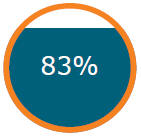





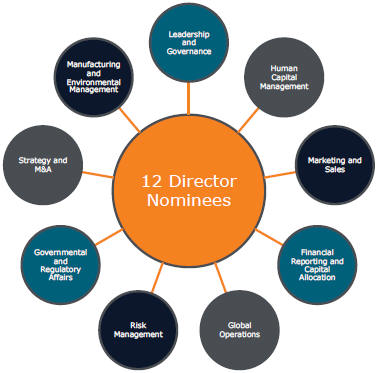








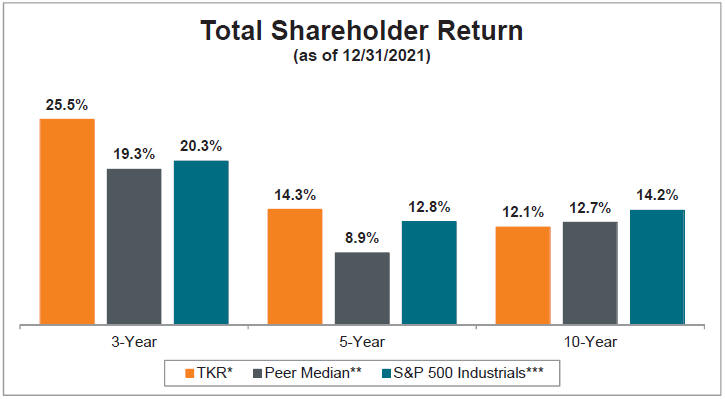





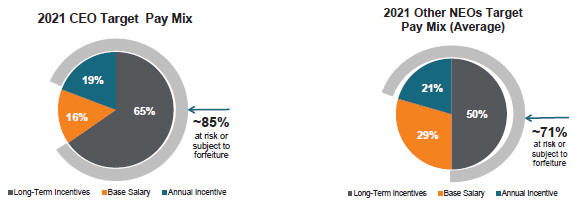



























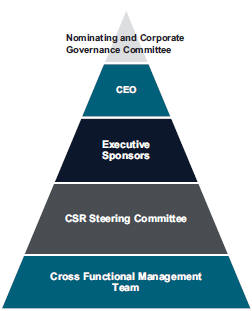
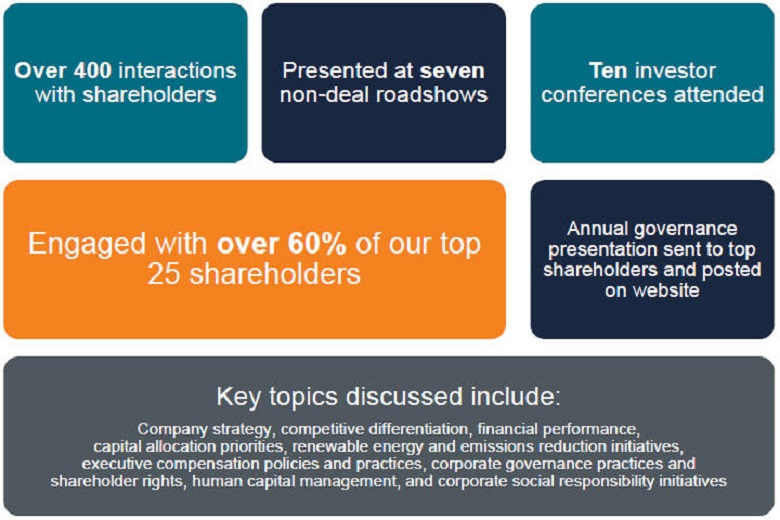













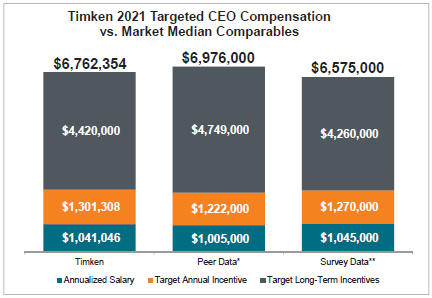


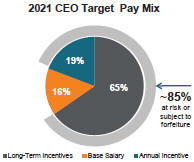












 Proxy must be signed and dated below. Please fold and detach card at perforation before mailing.
Proxy must be signed and dated below. Please fold and detach card at perforation before mailing.